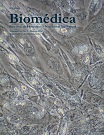Bronchopulmonary dysplasia epidemic: Incidence and associated factors in a cohort of premature infants in Bogotá, Colombia
Abstract
Introduction: There is a perception that bronchopulmonary dysplasia incidence has increased in Bogotá since 2000. This study estimates its incidence, compares it with historical data and describes associated factors.
Materials and methods: We carried out a prospective analytical cohort of preterm newborns ≤34 weeks of gestational age without major malformations from 12 health facilities from Bogotá in 2004. The main outcomes were incidence and severity of bronchopulmonary dysplasia, which were compared with an historical cohort (1994-1999).
Results: Neonatal mortality was 80/496, and the bronchopulmonary dysplasia incidence was 54.3% (95% CI, 49.4–59.1). When controlling for type of institution (low and high mortality) it appeared that being born in an institution with low mortality decreased the risk for death (OR=0.308; 95% CI, 0.129-0.736) but increased the odds for moderate-severe bronchopulmonary dysplasia (OR=1.797; 95% CI, 1.046-3.088). The risk for bronchopulmonary dysplasia was higher than for the historical control cohort (RR=1.924; 95% CI, 1.686-2.196). Weight and gestational age at birth, mechanical ventilation, intrauterine growth restriction and type of institution (low vs. intermediate-high mortality) were independently associated with bronchopulmonary dysplasia of increasing severity or even death.
Conclusions: The frequency of bronchopulmonary dysplasia in Bogotá has increased markedly, and this cannot be explained solely by better survival of more fragile infants. Survivors–irrespective from gestational age– have more frequent and more severe respiratory sequels. Probably suboptimal aggressive respiratory care practices associated with a recent transition from restricted to almost universal access to mechanical ventilation in neonatal intensive care units in Bogota might be compromising the quality of neonatal respiratory care.
Downloads
Some similar items:
- Luis Alfonso Pérez, Diana Marcela González, Karen Margarita de Jesús Álvarez, Luis Alfonso Díaz-Martínez, Nasal CPAP versus mechanical ventilation in 28 to 32-week preterm infants with early surfactant administration , Biomedica: Vol. 34 No. 4 (2014)
- Sandra Lorena Girón, Julio César Mateus, Fabián Méndez, Impact of an open waste disposal site on the occurrence of respiratory symptoms and on health care costs of children , Biomedica: Vol. 29 No. 3 (2009)
- Juan Gabriel Piñeros, Margarita Arboleda, Juan Camilo Jaramillo, Silvia Blair, Report of five cases of severe neonatal Plasmodium vivax malaria in Urabá, Colombia , Biomedica: Vol. 28 No. 4 (2008)
- Andrés Leonardo González, Ruth Aralí Martínez, Luis Ángel Villar, Clinical evolution of dengue in hospitalized patients , Biomedica: Vol. 28 No. 4 (2008)
- Jairo Echeverry, Carlos Mauricio Hurtado, Myriam Gutiérrez, Clinical manifestations of lead levels in children exposed to automobile battery recycling processes in Soacha and Bogotá, D.C. , Biomedica: Vol. 28 No. 1 (2008)
- Olga Lucía Morales, María de la Luz Valencia, Carolina Gómez, María del Pilar Pérez, Emilio Sanín, Luz Marina Vásquez, Chest wall mesenchymal hamartoma: a case report , Biomedica: Vol. 30 No. 1 (2010)
- José Fernando Pinzón, Carlos Maldonado, Jorge A. Díaz, Omar Segura, Direct costs and hospital morbimortality impact from preventable adverse drug events , Biomedica: Vol. 31 No. 3 (2011)
- Husein Husein-El Ahmed, Guillermo Arturo Cañadas-De la Fuente, Rafael Fernández-Castillo, Emilio González-Jiménez, Jesús Cantero-Hinojosa, Marita Lardón-Fernández, Generalized cutaneous candidiasis in newborn at term , Biomedica: Vol. 32 No. 2 (2012)
- Edna Catering Rodríguez, Sandra Yamile Saavedra, Aura Lucía Leal, Carlos Álvarez, Narda Olarte, Alberto Valderrama, Sonia Isabel Cuervo, Javier Escobar, The spread of KPC-3 Klebsiella pneumoniae in hospitals in Bogotá over a three-year period (2008-2010) , Biomedica: Vol. 34 (2014): Abril, Suplemento 1, Resistencia bacteriana
- Beatriz Eugenia Alvarado, Luis Reinel Vásquez, Social determinants, feeding practices and nutritional consequences of intestinal parasitism in young children. , Biomedica: Vol. 26 No. 1 (2006)
| Article metrics | |
|---|---|
| Abstract views | |
| Galley vies | |
| PDF Views | |
| HTML views | |
| Other views | |


























